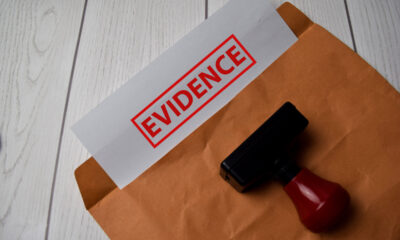In September of 2021, Texas made some drastic and somewhat controversial changes to its prostitution…
You’ve gotten lost in your thoughts while making the three-hour drive to your family’s house for Christmas. Unfortunately, your mind was so clouded that you didn’t notice the sign lowering the speed limit or the officer with a speed gun sitting just beside the sign. Instead, it’s the flashing red and blue lights in your rearview mirror that snap you out of your thoughts. You’re confused as to why you got pulled over. You keep your hands on the steering wheel waiting for the officer. She informs you that you were driving 10 mph over the speed limit and returns to her vehicle to run your name. The officer returns to write you a traffic ticket. Getting a ticket for driving 10 mph seems a little ridiculous to you—especially when warnings are an option. You start asking yourself, “how do the police detect speeds anyway?”
Getting pulled over can make your heart drop to the pit of your stomach. Even if your license is in good standing, the possibility of an expensive ticket can make you anxious. However, even if an officer clocks you with a speed gun, you may have a valid defense in fighting a speeding ticket.
How do police detect speeds?
At least 1 in 10 drivers get stopped for speeding in the United States every year. About 70% of these drivers actually get tickets and only 5% of those who receive speeding tickets actually challenge it. In many cases, challenging a speeding ticket can result in a dismissal. In order to challenge a ticket, you need to understand the means that the officer used to determine your speed. There are two main ways that police detect speeds.
Speed guns
In many cases, police use sophisticated radar or LiDAR guns to determine how fast a vehicle is moving. Both of these devices are used to identify distance and speed. In other words, they determine how far away an object is or how fast they are moving.
To determine the speed of moving objects, a radar gun will send several signals toward a moving vehicle. As the vehicle moves toward the radar gun, the return signal has a shorter distance to travel. The radar device will use this change in frequency to determine the speed of the car.
These guns are designed to measure vehicles at a somewhat constant speed. Vehicles changing speed greater than a radar gun’s accuracy cannot be measured.
Pacing
Another way officers may track your speed is a method called pacing. This is the practice of when a police officer follows a suspected speeder. To determine your speed, the officer uses their own speedometer to clock the suspect’s speed. Some states require that officers verify speeds by following a suspect over a certain distance. Still, even in states that don’t require pacing, officers will try to follow you for a reasonable distance to build the evidence against you, should you contest the ticket.
How do radar guns work?
Radar stands for Radio Detection And Ranging. The guns feature a radio transmitter and receiver. They work by sending radio waves to detect and monitor moving objects. Essentially, the gun transmits radio waves that bounce off of moving. The waves will then echo back to the receiver of the radar gun.
What is LiDAR?
Where radar uses radio waves, LiDAR uses light signals to send out a beam of light to a specific targeted vehicle. They work the same as radar, but can be much more accurate.
The reason LiDAR is more accurate than radar is because of the differences in sound and light waves. With radio waves, the beam spreads out into a cone rather than a single point. As a result, but the time a radio wave reaches a car 1,500 feet down the road, this cone has expanded to the entire width of the roadway. Any vehicle in that cone could possibly be the vehicle reflecting the signal back to the radar gun. This could open up the possibility to a police officer writing a ticket to the wrong driver. These tickets can be easily fought in court, should the driver decide to challenge the citation.
Laser, on the other hand, spreads much most slowly than radar. This is just one reason that LIDAR is more accurate than radar.
How accurate are police radar and lidar guns?
Under ideal conditions, police detecting speeds with radar guns are accurate within about 1-2 mph. LiDAR guns tend to be a bit more accurate because of the precise targeting of lasers. LiDar guns can’t be used from a moving patrol vehicle, however, radar can.
What can negatively impact a speed gun reading?
While these devices may seem like a slam dunk of your guilt, there are many challenges against radar and lidar gun evidence.
Calibration record evidence
The best and quickest way to challenge a radar gun as evidence is to get the calibration records for the device that clocked your speed. These devices have to be calibrated with set timeframes. In addition, if a radar gun wasn’t calibrated correctly, you may be able to argue that the judge should dismiss your speeding ticket.
To calibrate a radar gun, officers must use a tuning fork. Some officers may believe that they can calibrate the radar without using the tuning fork. If they did not use this tool, again, this opens the ticket up to a viable courtroom challenge.
What is the problem with pacing?
Pacing can be a faulty method of determining speed as well. For example, if an officer fails to keep an equal distance between themself and the suspected offender, then it’s possible the pacing was faulty.
Why is challenging a speeding ticket important?
While speeding tickets may seem like insignificant inconveniences, they can actually have long-lasting consequences. For example, a speeding ticket can lead to the following consequences:
- Fines. Traffic ticket fines in Texas are tiered and depend on the severity of the infraction. The average ticket in Texas costs about $101, however, in some areas, drivers can be upwards of $500.
- Raised insurance premiums. In many cases, drivers fight tickets because they don’t want to pay significant increases in their insurance premiums. If you receive a ticket every couple of years, you likely won’t deal with raised premiums. However, this can be a concern for those who have received several tickets within a short period of time.
- License suspension. In certain areas of the country, it is necessary to have a license and a vehicle. However, if you amass too many points on your driving record you can get driver’s license suspended.
Do I have to sign for a speeding ticket?
Yes. If you fail to sign for a ticket, the officer can arrest you on the spot. However, it is important to note that signing for the ticket is not an admission of guilt. Signing for a ticket means that you’ve agreed to appear in court before a judge.
Do I have to pay out of state tickets?
Yes. Regardless of where you live, signing for a ticket means that you’ve either agreed to pay the citation or appear in court. If you fail to do one or the other, the court in the issuing jurisdiction can put a warrant out for your arrest.
If you want to fight a ticket from out state, your best bet is to hire an attorney to appear in court on your behalf.
The Carlson Law Firm can help
The Carlson Law Firm has the resources to help you through the process of fighting traffic violations. We have in-house private investigators who are on your side. Our team of Texas Traffic Ticket Attorneys can provide you with the tools to pursue lower charges or to even have charges dismissed. We have a team of knowledgeable attorneys who can help you protect your driving rights.
Don’t simply accept a guilty charge for a speeding ticket violation. These violations can remain on your permanent driving record. Convictions can result in the loss of your driver’s license and more.
Contact us today to speak with a qualified legal representative. Consultations are free. We are available 24/7.



